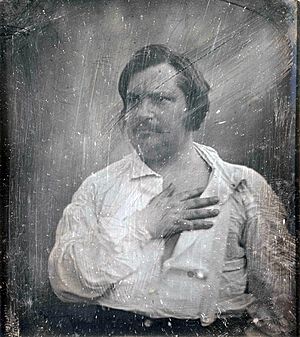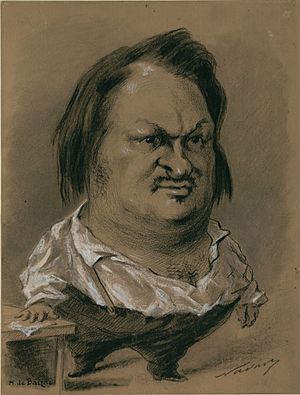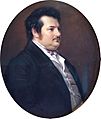Honoré de Balzac facts for kids
Quick facts for kids
Honoré de Balzac
|
|
|---|---|

Honoré de Balzac on an 1842 daguerreotype
by Louis-Auguste Bisson |
|
| Born | 20 May 1799 |
| Died | 18 August 1850 (age 51) Paris, France
|
| Occupation | Novelist, playwright |
| Spouse(s) | Ewelina Hańska |
Honoré de Balzac (born May 20, 1799 – died August 18, 1850) was a famous French writer. He wrote many novels and plays. His most well-known work is La Comédie humaine. This is a huge collection of novels and short stories. It shows what French life was like after the year 1815.
Some of his most famous books from this collection include La Peau de chagrin (1831), Eugénie Grandet (1833), and Le Père Goriot (1835). Balzac's stories had a big influence on many other writers. These included Marcel Proust, Émile Zola, Gustave Flaubert, Charles Dickens, and Edgar Allan Poe.
Contents
Biography
His Family and Early Life
Honoré de Balzac was born into a family that wanted to be respected. His father, Bernard-François Balssa, came from a large family in the south of France. In 1760, he went to Paris to make a better life for himself. He became a secretary to the King's Council. He also changed his name to "Balzac" to sound more noble. Honoré later added "de" to the name.
Balzac's mother, Anne-Charlotte-Laure Sallambier, came from a wealthy family in Paris. She was 18 when she married François Balzac, who was 50.
Honoré was the second child in his family. His older brother had died as a baby. Honoré's sisters, Laure and Laurence, were born in 1800 and 1802. His younger brother, Henry-François, was born in 1807.
As a baby, Balzac was sent to a wet nurse. This was common for middle and upper-class families back then. He and his sister Laure spent four years away from home. When they returned, their parents kept a distance from them. This affected Balzac a lot. His novel Le Lys dans la vallée (1835) features a strict caregiver, much like his own.
When he was ten, Balzac went to a school in Vendôme. He studied there for seven years. His father wanted him to learn to work hard. So, he gave Honoré very little money. This made him feel different from his richer schoolmates.
Balzac found it hard to learn by simply memorizing things. He was often sent to a punishment cell called the "alcove." The school janitor later said he remembered Balzac well because he took him to the dungeon over a hundred times! But being alone gave Balzac lots of time to read any book he could find.
Balzac used his school experiences in his books. His novel Louis Lambert (1832) is about a boy at a school like the one in Vendôme. The story says the boy "devoured books of every kind." He loved reading dictionaries when he had no other books.
Balzac often got sick. Once, the headmaster told his family he was in a "sort of a coma." Balzac thought it was from "intellectual congestion." But being locked up in the "alcove" probably played a part too.
In 1814, Balzac's family moved to Paris. Honoré studied with private teachers for two and a half years. This was not a happy time for him.
In 1816, Balzac went to the Sorbonne. He studied with famous professors. One of them, Victor Cousin, taught philosophy and encouraged students to think for themselves.
After his studies, Balzac's father wanted him to become a lawyer. For three years, he trained and worked in a law office.

In 1819, Balzac was offered a chance to take over the law office. But he had enough of law. He didn't want to be "a clerk, a machine." He wanted to be a writer. This made his family upset. But they let him live in a small, simple room in Paris. The rest of his family moved outside the city.
Becoming a Writer
Balzac's first writing idea was for a comic opera called Le Corsaire. But he couldn't find a composer.
In 1820, he finished a play called Cromwell. He read it to his family, but they didn't like it. He then started three novels but never finished them.
In 1821, Balzac met Auguste Le Poitevin. Auguste convinced him to write short stories that he would sell to publishers. Balzac soon started writing longer works. By 1826, he had written nine novels. He published them using fake names and sometimes worked with other writers.
=La Comédie Humaine and Success
After writing several novels, Balzac had a big idea in 1832. He wanted to write a series of books that would show "all aspects of society." He ran to his sister's house and shouted, "I am about to become a genius!" This huge project became known as La Comédie Humaine. He put all the stories he published under his own name into this collection. It became his life's work and his greatest achievement.
Les Chouans (1829) was the first book Balzac published under his real name. It made him a known author, not just someone using fake names.
He signed El Verdugo as "Honoré de Balzac." He added the "de" to sound more like a nobleman. This was a choice he made, not something he was born with.

In 1831, La Peau de chagrin became a success. It's a story about a sad young man named Raphaël de Valentin. He finds an animal skin that gives him power and wealth. But he can't control these things, and his health gets worse. Balzac wanted the story to show how life can be tricky.
In 1833, Balzac released Eugénie Grandet, which was his first best-seller. It's about a young woman who becomes very careful with money, like her father. This book also got the best reviews of his career. After that came La Duchesse de Langeais, which many say is one of his most beautiful novels.
Le Père Goriot (Old Father Goriot, 1835) was his next success. In 1836, Balzac took charge of a weekly magazine called Chronique de Paris. It published three issues.
Le Cousin Pons (1847) and La Cousine Bette (1848) tell the story of Les Parents Pauvres (The Poor Relations). These books show how people fight over wills and money. Balzac knew about this from his time as a law clerk. His health was getting worse, so finishing these books was a big deal.
Many of his novels were first published in parts, like in a newspaper. Their length was not set beforehand. Illusions Perdues became a thousand pages long. But La Fille aux yeux d'or (The Girl with the Golden Eyes, 1835) started big but ended up as a short novel of only fifty pages.
How He Worked
Balzac's work habits were famous. He wrote from 1 AM to 8 AM every morning, and sometimes even longer. He could write very fast. Some of his novels, written with a quill pen, were as fast as typing thirty words a minute today.
His favorite way to work was to eat a light meal in the late afternoon. Then he would sleep until midnight. He would wake up and write for many hours, drinking lots of black coffee. He often worked for 15 hours or more at a time. He once said he worked for 48 hours with only three hours of rest.
Balzac changed his writing a lot. He would cover the printed pages with changes and additions. He sometimes did this many times while a book was being published. This cost him and the publisher a lot of money. Because of this, the final book was often very different from the first version. Some of his books were never finished. But some, like Les employés (The Government Clerks, 1841), are still praised by critics.
Balzac sometimes lived like a hermit and sometimes traveled a lot. But he always knew what was happening in society. This helped his writing. He was friends with other writers like Théophile Gautier and Pierre-Marie-Charles de Bernard du Grail de la Villette. He also knew Victor Hugo.
He didn't spend as much time at fancy parties in Paris as some of his characters. He was too busy writing. He felt it was his job to create society in his books, not just be part of it. He often stayed at the Château de Saché near Tours. This was the home of his friend Jean de Margonne. Many of Balzac's troubled characters were thought up in a small bedroom there. Today, the chateau is a museum about the author's life.
Marriage and Death
In February 1832, Balzac received a mysterious letter from Odessa. It had no return address and was signed "L'Étrangère" ("The Foreigner"). The letter said she was sad about the negative parts of his book La Peau de Chagrin. Balzac replied by putting a classified advertisement in a newspaper. He hoped his secret critic would see it. This started a 15-year exchange of letters between Balzac and Ewelina Hańska.


Ewelina was married to a nobleman much older than her. He was a wealthy Polish landowner. Ewelina found a special connection with Balzac.
Her husband died in 1841. This finally gave Ewelina and Balzac a chance to be together. Balzac visited Countess Hańska in St. Petersburg in 1843 and won her heart. After some problems, they finally got permission to marry.
On March 14, 1850, Balzac's health was very bad. They traveled by carriage to a church in Berdychiv, Ukraine, where they were married. The long journey was hard on both of them. Balzac had severe heart problems.
In late April, the newly married couple left for Paris. Balzac's health got worse on the way. They arrived in Paris on May 20, his 51st birthday.
Five months after his wedding, on August 18, 1850, Balzac died. His mother was with him. His wife, Eve de Balzac, had gone to bed. Victor Hugo visited him that day. Hugo later spoke at Balzac's funeral.
Balzac is buried at Père Lachaise Cemetery in Paris. At his funeral, Victor Hugo said, "Today we have people in black because of the death of the man of talent; a nation in mourning for a man of genius." Many writers from Paris attended the funeral.
Later, a statue of Balzac was made by the famous French sculptor Auguste Rodin. This bronze statue, called the Monument to Balzac, has stood in Paris since 1939. Rodin also made smaller sculptures of Balzac.
Works
Novels
- Les Chouans (1829)
- La Maison du chat-qui-pelote (1829)
- La Vendetta (1830)
- La Peau de chagrin (1831)
- Les Proscrits (1831)
- Louis Lambert (1832)
- Eugénie Grandet (1833)
- Le Médecin de campagne (1833)
- Ferragus, chef des Dévorants (1833)
- La Duchesse de Langeais (1834)
- La Recherche de l'absolu (1834)
- Séraphîta (1834)
- Le Père Goriot (1835)
- Le Lys dans la vallée (1835)
- Le Contrat de mariage (1835)
- La Vieille Fille (1836)
- César Birotteau (1837)
- Le Cabinet des Antiques (1838)
- Une fille d'Ève (1838)
- Béatrix (1839)
- Le Curé de village (1839)
- Un grand homme de province à Paris (1839)
- Ursule Mirouët (1841)
- Une ténébreuse affaire (1841)
- Mémoires de deux jeunes mariées (1841)
- La Fausse Maîtresse (1841)
- La Femme de trente ans (1829–1842)
- Albert Savarus (1842)
- La Rabouilleuse (1842)
- Un début dans la vie (1842)
- Illusions perdues (1837-1843)
- Honorine (1843)
- Modeste Mignon (1844)
- La Cousine Bette (1846)
- Splendeurs et misères des courtisanes (1838–1847)
- Le Cousin Pons (1847)
- L'Envers de l'histoire contemporaine (1848)
- Les Paysans (1855)
Published pseudonymously
As "Lord Rhône", in collaboration
- L'Héritière de Birague (1822)
- Jean-Louis (1822)
As "Horace de Saint-Aubin"
- Clotilde de Lusignan (1822)
- Le Centenaire (1822)
- Le Vicaire des Ardennes (1822)
- La Dernière Fée (1823)
- Annette et le Criminal (Argow le Pirate) (1824)
- Wann-Chlore (1826)
Published anonymously
- Du Droit d'aînesse (1824)
- Histoire impartiale des Jésuites (1824)
- Code des gens honnêtes (1826)
Incomplete at time of death
- Le Corsaire (opera)
- Sténie
- Falthurne
- Corsino
- Le Député d'Arcis
Novellas
- Le Bal de Sceaux (1830)
- Sarrasine (1830)
- Une double famille (1830)
- La Paix du ménage (1830)
- Gobseck (1830)
- El Verdugo (1830)
- Le Colonel Chabert (1832)
- Le Curé de Tours (1832)
- La Fille aux yeux d'or (1835)
- Les Secrets de la princesse de Cadignan (1839)
- Z. Marcas (1840)
- L'Amour masqué (1911)
Short Stories
- Étude de femme (1830)
- Adieu (1830)
- Le Chef-d'œuvre inconnu (1831)
- La Grande Bretèche (1831)
- Le Réquisitionnaire (1831)
- L'Auberge rouge (1831)
- La Comédie du diable (1831)
- La Bourse (1832)
- La Grenadière (1832)
- Le Message (1832)
- Un drame au bord de la mer (1834)
- La Messe de l'athée (1836)
- Facino Cane (1837)
- Le Succube (1837)
- Gambara (1837)
- Massimilla Doni (1837)
- Pierre Grassou (1839)
- Un épisode sous la Terreur (1842)
Short Stories Collection
- Les Cent Contes drolatiques (1832–1837)
Plays
- L'École des ménages (1839)
- Vautrin (1839)
- Pierre Grassou (1839)
- Les Ressources de Quinola (1842)
- Paméla Giraud (1842)
- La Marâtre (1848)
- Mercadet ou le faiseur (1848)
Tragic verse
- Cromwell (1819)
Images for kids
-
Monument to Balzac by Auguste Rodin at Place Pablo-Picasso, Paris
-
Bust of Balzac by Auguste Rodin (1892), displayed at the Victoria and Albert Museum in London
See also
 In Spanish: Honoré de Balzac para niños
In Spanish: Honoré de Balzac para niños










